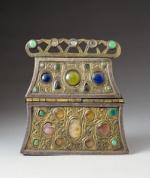Carolingian Reliquary
UNKNOWN ARTIST
The J. Paul Getty Museum
Los Angeles, US
8th century
The Carolingian Reliquary is a significant artifact from the Carolingian period, dating back to the rule of the Frankish Emperor Charlemagne and his successors in the late 8th and early 9th centuries. These reliquaries were ornate containers designed to hold relics, such as bones or other sacred objects believed to possess spiritual significance. Crafted from precious materials like gold, silver, and gemstones, Carolingian reliquaries often featured intricate designs and elaborate decorations, reflecting the wealth and religious fervor of the time. They served as both symbols of devotion and status symbols for the rulers and religious institutions of the Carolingian Empire. These relics played a crucial role in the religious and political landscape of medieval Europe, acting as focal points for worship and pilgrimage, and they continue to be valued as important historical and cultural artifacts today.
Type
Sculpture, gilt copper, silver, cabochon hardstones, and glass pastes
13 × 12.1 × 4.6 cm
